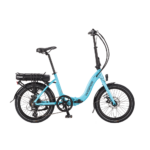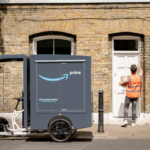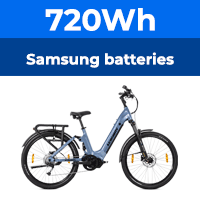I will readily admit to being a bit eccentric . My favourite type of battery is lead acid . Why ? because it does what I want it to do at a price I can afford . I understand that in China there will be no more bikes made with lead acid batteries . I have no personal experience of Li-po batteries , but , reading the forum , I suspect that a lot of people feel that they are some what unreliable and short lived given the high cost . On the balance , I feel that NiMH batteries were a far better compromise as regards price /weight /cost . They now seem to be hard to get . Is there a case for bringing them back ? What do YOU think ?
Give the customer what they want
- Thread starter neptune
- Start date
I bemoaned the demise of the NiMh e-bike battery in 2006/7, when it was clearly superior to the lithium ones at the time. Thats no longer true though, and if reintroduced they would hardly be any cheaper. Add in the weight issue, in one example the 10 Ah at 5.2 kilos now replaced with Li-polymer at 3.1 kilos, and I no longer want them back, though the choice would be nice in an ideal world.
Good lithium batteries now are reliable and perform extremely well, the longer lasting LiFePO4 type matching and even exceeding NiMh for longevity on a range loss basis.
Good lithium batteries now are reliable and perform extremely well, the longer lasting LiFePO4 type matching and even exceeding NiMh for longevity on a range loss basis.
Hi flecc . As I said I have no personal experience except lead acid . It is great news that the latest LiFePO4 batteries are lasting longer . According to some reports , there are probably much better batteries in the pipeline .
It would be great to think we will live to see batteries that cost 20% of todays price , and carry a five year guarantee . People talk about an electric bike using 1 pennyworth of electricity per mile . But battery depreciation could easily double or quadruple that figure . Imagine if you bought a car , and found that they now fit a large fuel tank that will not need filling for 4000 miles , and it is full when you buy the car . But the tank and fuel accounts for 40% of the total cost of the car . I think that better and cheaper batteries would revolutionise the electric bike .
It would be great to think we will live to see batteries that cost 20% of todays price , and carry a five year guarantee . People talk about an electric bike using 1 pennyworth of electricity per mile . But battery depreciation could easily double or quadruple that figure . Imagine if you bought a car , and found that they now fit a large fuel tank that will not need filling for 4000 miles , and it is full when you buy the car . But the tank and fuel accounts for 40% of the total cost of the car . I think that better and cheaper batteries would revolutionise the electric bike .
The LifePo4 battery is effectively the replacement for lead acid...it's only downside is it's weight relative to Li-Ion but obviously thats no problem relative to lead acid. I am in contact with an asian battery supplier who says he can make a 16Ah LifePo4 weighing less than 5 kgs and good for 3000 plus cycles,no price yet though! In the meantime our replacement 36v x10Ah LifePo4 batteries must be good value at £208.00.
Dave
KudosCycles
Dave
KudosCycles
Last edited:
They're here now, electric cars like the Nissan Leaf hatchback. Car with battery is well over £31,000, replacement battery over £16,000. They say the battery will last 7 years, but we've all heard manufacturer's stories about battery life. More to the point is that they warranty it for 5 years.Imagine if you bought a car , and found that they now fit a large fuel tank that will not need filling for 4000 miles , and it is full when you buy the car . But the tank and fuel accounts for 40% of the total cost of the car
Does anyone remember NiFe or nickel-Iron batteries ? I have mentioned these to lots of people in various fields , and no one seems to have heard of them , or confuse them with Nickel Cadmium . These cells were , I believe, invented by Edison . They came as separate self contained cells which were connected by bus bars . Each cell was 1.2 volts . The electrolyte was a solution of potassium hydroxide . I know they existed , because I once owned some . They were quite expensive , but had several advantages . They could be stored totally discharged without damage for long periods . Claimed life was at least 10 years , after which you had to renew the electrolyte , and they were then good for another ten years . A local auto electrician told me they were once used as starter batteries on milk tanker lorries {he did not know why }. I know that they took up more space than an equivalent lead acid battery , but I believe they were considerably lighter . I seem to think they were at one time available on the government surplus market . In spite of their large volume , they might have been ideal for electric bikes .
NiFe batteries were quite common in the 'secondary lighting' market. In such an application they would have been trickle charged continually to keep them ready to go in the event of a mains failure.
For those who are not familiar, when mains supplies were not too reliable proper wired secondary lighting installations were quite common. I'm not talking about the illuminated exit signs or self-contained units which are designed to help you to find your way out when the mains failed - these installations would have been good enough to work by until the power came back on.
As I recall, they do have a certain self-discharge characteristic, so you can't leave them unconnected for too long or they just go flat - but without damage, as was mentioned. In a secondary lighting installation this was very desirable, as in the event of a long power outage they would just go flat and the lights would gradually get dimmer until they went out - but the batteries would not be harmed and would recharge happily when the power was restored.
They weren't around for too long - lead acid has always been king in that market, and still is.
Rog.
For those who are not familiar, when mains supplies were not too reliable proper wired secondary lighting installations were quite common. I'm not talking about the illuminated exit signs or self-contained units which are designed to help you to find your way out when the mains failed - these installations would have been good enough to work by until the power came back on.
As I recall, they do have a certain self-discharge characteristic, so you can't leave them unconnected for too long or they just go flat - but without damage, as was mentioned. In a secondary lighting installation this was very desirable, as in the event of a long power outage they would just go flat and the lights would gradually get dimmer until they went out - but the batteries would not be harmed and would recharge happily when the power was restored.
They weren't around for too long - lead acid has always been king in that market, and still is.
Rog.
Last edited:
Hi Rog . I am pleased someone else has experience of these batteries , as I was beginning to think that I had imagined them ! My grandchildren are still amazed when I tell them that I never saw an electric light until I started school . Until about 1960 , houses without mains electricity were still quite common in rural Lincolnshire . My brother married in 1960 , and moved into a rural Council house with no mains . There was a guy in our village who was the envy of his neighbours . He had two 25 watt electric lamps powered by an old Lucas "Freelight " wind generator . He had NiFe babtteries , although these were not the standard batteries for the generator . If he had a long period without wind , the batteries would go flat , and sit without damage until the wind blew again . I wonder if you know how they compared to lead acid as regards weight .
Very true. But oh my how things change. They've all got running electric and indoor lavs now. There's even talk of a house in Grantham with a bidet (and in the bathroom too, not in the garden with geraniums in it).Until about 1960 , houses without mains electricity were still quite common in rural Lincolnshire .
This is getting a bit off topic so I'll keep it short. Being a little past my sell-by date I recall in Manchester a good few houses with only gas - no electricity. So, not just a rural thing, although there would have been electricity available in the street.My grandchildren are still amazed when I tell them that I never saw an electric light until I started school . Until about 1960 , houses without mains electricity were still quite common in rural Lincolnshire .
I wonder if you know how they compared to lead acid as regards weight .
Also at the same time DC mains in some parts of Manchester (220V) and AC in others (230 or 240V) Blackpool, where I went to boarding school, was 210V AC - decidedly odd.
As I recall NiFe batteries were a good deal lighter than their lead acid counterparts watt-for-watt. No surprise there. However, they were certainly larger too.
Rog.
Thanks for that interesting reply Rog . Off topic ? I am a "new boy " here , but I would have thought that when the forum is relatively quiet , it is better that we talk about anything rather than nothing .The history of public power supply is fascinating to me . In Boston we never had DC mains , though the first use of electricity in town was a private system that supplied just the docks . The problem with DC mains is that you can not use transformers , so the power must be generated distributed and used , all at the same voltage . This means that to bring line losses within an acceptable value , the service area is limited to a radius of about 3 miles , and that is with copper cables as thick as your arm . Going back to NiFe batteries , if you could design the bike to cope with the volume , a twenty year battery would appeal to me . Also , I think NiFe would be easy to recycvle and low on toxicity .
ADDED LATER . Just been researching NiFe batteries on google . In just a few minutes I have found some interesting stuff . It would appear that some of Edisons original cells are still working and STILL IN USE after 70 years . Also NiFe batteries were used in some early electric cars in the early years of motoring . A guy called Alvin Snaper has recently been working on resurrecting and improving NiFe batteries . He came up with a new way to make metal electrodes in a sponge like form . Then he realised that the same idea could also be applied to lead acid . He has patents on such a battery which has half the weight, half the size and double the capacity of the traditional lead acid , and 90% less lead content .. He has sold his patents to a manufacturer . So the battery of tomorrow may not be a Lithium battery after all .
ADDED LATER . Just been researching NiFe batteries on google . In just a few minutes I have found some interesting stuff . It would appear that some of Edisons original cells are still working and STILL IN USE after 70 years . Also NiFe batteries were used in some early electric cars in the early years of motoring . A guy called Alvin Snaper has recently been working on resurrecting and improving NiFe batteries . He came up with a new way to make metal electrodes in a sponge like form . Then he realised that the same idea could also be applied to lead acid . He has patents on such a battery which has half the weight, half the size and double the capacity of the traditional lead acid , and 90% less lead content .. He has sold his patents to a manufacturer . So the battery of tomorrow may not be a Lithium battery after all .
Last edited:
Quick update re previous post . An American company is releasing a new range of traction batteries this summer, using the sponge electrode technology . They are called Firefly`s Group31batteries . They claim
Double the range
quadruple the life
a slight reduction in weight .
Who says Lead is dead ?
Double the range
quadruple the life
a slight reduction in weight .
Who says Lead is dead ?
@Biged . I can only report what I read . Aparently there has been litigation regarding the intellectual property , which has recently been resolved .
I just recently went to LiPo from SLA, at a weight of approximately 1.5 kg I have slightly more USABLE wattage that an 18 kg SLA pack, oh and the LiPo were cheaper.
I have no qualms leaving the older tech behind now that Lithium is getting cheaper and more stable.
And with electric cars taking off they should mature more and drop further.
I have no qualms leaving the older tech behind now that Lithium is getting cheaper and more stable.
And with electric cars taking off they should mature more and drop further.
Now there's an optimist!with electric cars taking off
Last year's sales in Britain of all models of electric cars from the eight main manufacturers of these were under 7% of the forecast for just one model from just one of the manufacturers.
"Nissan Leaf Reaches 10,000 Units Sold In The US" From autoguide
I know it will take time but the research means our batteries get better faster, and the above figure is better than I expected considering it is not even available in all states.
And its a hell of a lot more EV's than say 2 years ago
I know it will take time but the research means our batteries get better faster, and the above figure is better than I expected considering it is not even available in all states.
And its a hell of a lot more EV's than say 2 years ago
If you research that as I've done, this is for paper sales in the USA and the cancellations are pouring in. Many will never hit the road."Nissan Leaf Reaches 10,000 Units Sold In The US" From autoguide
I know it will take time but the research means our batteries get better faster, and the above figure is better than I expected considering it is not even available in all states.
And its a hell of a lot more EV's than say 2 years ago
That said, it was bound to shift more in the USA where the new is easier to sell and much of the population has a large disposable income, but when reality hits home, future sales will slump. Europe is more cautious and as you see from the British results, people are looking into the reality first and concluding they are just not worth it. Only a very few of the wealthy who can afford to throw away around £25k to £32k are buying.
The intrinsic problem, apart from the very short range, is the s/h price, and the industry has no solution to it. Normally a second hand popular hatchback will fetch not far short of half price at about 4 years old, but the £31,000 Leaf at that age will be near to needing a new £16,000 battery. Nobody in their right mind will pay half the original price knowing they will soon face another £16000 bill, bringing it up to the new price. Therefore it will be a write off at four to five years old.
.
Last edited:
@GeeBee . I am being sincere when I say that I hope the Lipo lives up to expectations . I personally feel that advances in battery technology will be driven by China`s "no more lead batteries for electric bikes " policy Rather than the electric car market .Needles to say , the car market could well benefit as well . There will be lead batteries available for a long time , due to their widespread use in alarm systems , stand-by lighting etc .
Lipo (lithium polymer) is only a construction for lightness, it's not a chemistry and that is what determines battery performance.
In the e-car market there's confusion on the batteries to use. Nissan and Renault use LiFePO4, Mitsubishi and Peugeot/Citroen use Li-ion complex cathode batteries, Smart and Think (Ford) use molten salt (liquid sodium) batteries.
In hybrid petrol/electric cars, Chevrolet and BYD use LiFePO4 and Toyota use NiMh.
With four battery chemistries in use and that lack of agreement, I don't hold out too much hope for advances from there.
In the e-car market there's confusion on the batteries to use. Nissan and Renault use LiFePO4, Mitsubishi and Peugeot/Citroen use Li-ion complex cathode batteries, Smart and Think (Ford) use molten salt (liquid sodium) batteries.
In hybrid petrol/electric cars, Chevrolet and BYD use LiFePO4 and Toyota use NiMh.
With four battery chemistries in use and that lack of agreement, I don't hold out too much hope for advances from there.
Related Articles
-
 MTF Enterprises announces acquisition of EMU Electric Bikes
MTF Enterprises announces acquisition of EMU Electric Bikes- Started by: Pedelecs
-
 Wisper 806T folding bike wins Which? ‘Best Buy’
Wisper 806T folding bike wins Which? ‘Best Buy’- Started by: Pedelecs
-
 Sustrans calls for protected cycle lanes
Sustrans calls for protected cycle lanes- Started by: Pedelecs
-
 Amazon launch their first UK e-cargo micromobility hub
Amazon launch their first UK e-cargo micromobility hub- Started by: Pedelecs



